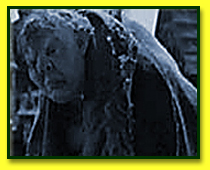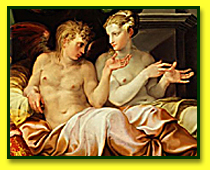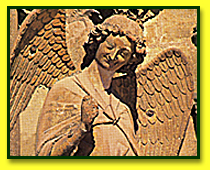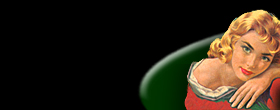Myths and Fairytale Origins
By Doris Nußbaumer
The Angélique series has fascinated innumerable readers, and one reason for the fascination might be the tremendous mix of mythical and fairytale elements with a story full of love, passion, adventure and suspense.
Harvey J Adkins, the chairman of Friends of Angélique, has pointed out the parallels between Angélique and The Beauty and the Beast, commenting "If there is a better and more beautiful example of a story of love between a 'beauty' and a 'beast' than that of Angélique and Joffrey, I would love to hear it."
I think that's it. I don't know a more beautiful version of the fairytale, although I have found a lot of examples of texts that tell the beauty and the beast story again in some way.
Doing a quick survey of literary motifs and characters, I found connections between Angélique, Beauty and the Beast, ancient Greek and Roman mythology and Christian legends/ideas, and I would like to invite you to join my journey through a quite wide and complicated field of intertextual relationships.
1: The Beauty and the Beast
 [Right: Charles Laughton in his famous portrayal of Quasimodo in the 1939 film, The Hunchback of Notre Dame.]
[Right: Charles Laughton in his famous portrayal of Quasimodo in the 1939 film, The Hunchback of Notre Dame.]
Firstly, an addition to Harvey's comparison of Angélique and The Beauty and the Beast.
The Austro-American psychoanalyst and educator Bruno Bettelheim wrote in The Uses of Enchantment that the symbolic meaning of The Beauty and the Beast is the following: a young girl just learning the truth about sexuality may easily imagine men as threatening, animal/bestial, strange.
During a process of maturing, she understands that a man isn't that wild beast from the woods, but an endearing partner to love and to live with. Of course, the tale has been interpreted in many different ways, but if we take this interpretation and have a look at Angélique we will see that Anne Golon has told exactly this symbolic/subconscious meaning of he Beauty and the Beast in plain text.
Secondly, as I said above, there are many novels, stage plays and films that are closely related to the beauty and the beast theme. I just want to mention three very well known examples: Cyrano de Bergerac by Edmond Rostand, The Hunchback of Notre-Dame by Victor Hugo, and The Phantom of The Opera by Gaston Leroux.
All three stories show a beautiful young woman confronted with what you might call a 'beast' - an ugly, stigmatized and disquieting man who turns out to be somehow interesting, somehow endearing. So a love story full of problems sets sail and... the rest is literature.
Of course, each of the books tells its own great story, but the basic themes are similar. Compared with Angélique, these three stories are tragedies, especially for the 'beasts' - Cyrano, Quasimodo and Eric. Their love remains unfulfilled. There is not and cannot be any magic transformation like there is in the fairytale, and the 'beauty' doesn't solve the redemption riddle, so the final redemption for the 'beast' in the story is death.
I enjoyed reading these stories, but I still prefer the plot Anne Golon developed: the 'beast' stays beastly, the 'beauty' learns that he is not that beastly at all, their love story begins, they are separated and reunited, the adventure goes on and on and on...
There's another reason why I mentioned Cyrano, Notre-Dame and The Phantom. They differ from the basic fairytale in an important point: there is an attractive rival who has good chances of winning the love of 'beauty' and making her reject the'beast'.
Of course, the height of absurdity (and of the author's creativity, in both meanings) is when Cyrano, the poet, ghost-writes his illiterate rival's love letters to Roxanne. And with Esmeralda having only Phoebus in her mind during the whole novel and Christine struggling between Eric and Raoul, finally deciding for Raoul and against the Phantom, we find that the 'rival' can be another important character in beauty/beast stories.
As this is an essay about Angélique, the next question must be: what is the role of the 'rival(s)' in the Angélique books? Are there rivals at all? In my opinion, the answer is both yes and no. No if you say that the love between Angélique and Joffrey is stronger and deeper than all other relationships in the text; yes if you see the other side. Angélique's love adventures, Joffrey's jealousy, Phillippe, King Louis XIV, Colin and so on are serious rivals and Joffrey takes them very seriously.
With the aspect of rivals, jealousy and the triangle relationship in mind, let me go to the next point I consider important for the Angélique series.
2: Greek and Roman Mythology
 [Left: Eros and Psyche - or Amor and Psyche - in a painting by Niccolò dell'Abate (1560).]
[Left: Eros and Psyche - or Amor and Psyche - in a painting by Niccolò dell'Abate (1560).]
Bruno Bettelheim again: the fairy tale The Beauty and the Beast, he says, is based on the Greek myth, Amor and Psyche (it should be Eros and Psyche because Amor is the Latin version, but there's so often a confusion of Greek and Roman names, so I will stay with the well-known title).
Let me give a brief summary of the tale. Psyche, an extremely beautiful human girl, is, against her will, worshipped like a goddess because of her beauty. Aphrodite, the goddess of love and beauty, gets jealous and gives her son, Eros/Amor, an order to make Psyche fall in love with the most awful monster he can find. Eros flies... (well, he is the winged guy with the golden arrows who is still responsible that people fall in love with each other!) to Psyche, looks at her - and falls in love with her.
He abducts her to his castle somewhere above the clouds and visits her every night in absolute darkness. They experience a wonderful love story, but Eros tells Psyche that she must never see him or ask him for his name. Of course, the agreement can't be kept, Psyche's evil and envious sisters take over the same role as the beauty's sisters in the French fairy tale, convincing the happy but doubting and nervous young woman that the man she loves is surely a monster, or why else would he avoid daylight?
So, one night, Psyche lights a candle to take a glance at her anonymous lover and is surprised and very pleased to find the god of love himself in her bed. But she drops a little bit of hot wax on Eros's skin, he wakes up and - the usual catastrophe.
Psyche is exiled and has to fulfill a lot of quite difficult tasks and impossible missions until she is forgiven her 'sin' of wanting to know the truth and is at last reunited with Eros.
In fact, there's at least one version where she doesn't make it. I am not sure, but I think Greek mythology decided to let Psyche die in exile, and the Roman versions tell the happy ending (this could be an explanation of why people, eager to hear happy endings, usually refer to Amor instead of Eros).
Perhaps it's just because the Roman gods and goddesses, heroes and heroines, seem to be more popular than their Greek predecessors (just take a look at the planet names...)
Of course, Amor and Psyche has left its traces in many fairytales, but except for ploughing the furrow for The Beauty and the Beast, where is the connection to Angélique? There are two aspects.
Firstly, I would like to encourage you to compare Angélique's husband to Psyche's. Connections? Similarities? Yes. Unlike with most other beauty/beast stories, Joffrey, the 'beast' is not shy, secluded, seperated from life. He appears as a selfconscious person, intelligent, charismatic, wealthy, performing his official duties as a duke of Aquitaine and, besides, having a lot of love affairs, whose rumours deeply shock young Angélique.
On the other hand, she has heard his golden voice, she has been impressed by his romantic poems and falls in love with him. So in a process of lighting the candle she discovers an incarnation of the god of love beside her instead of the monster she saw first.
The second aspect in this chapter refers to the question of rivalry and the triangle relationship, and leads us away from Amor and Psyche. There is another ancient myth that coincides with the basic structure of the Angélique story: the myth of Aphrodite and Hephaistos (in Roman mythology they are called Venus and Vulcan).
Aphrodite/Venus, goddess of love, is married with Hephaistos/Vulcan, the god of fire and the forge, who is traditionally described as physically ugly and lame, but a great artist who forges weapons and beautiful works of art for the gods. Their relationship is rather a chain of triangles than a partnership because the Greek poets thought that the goddess of love has to fulfil her destiny, so there are a lot of stories about Aphrodite's sexual adventures with gods, half-gods and humans.
The best-known sees Aphrodite have an affair with the attractive but cruel Ares (Roman Mars), the god of war. When Hephaistos finally finds out, he constructs a trap with an invisible and undestroyable copper net and catches the lovers in embrace to expose them to the judgement of the other gods.
Angélique, the great love story, and on the other hand a myth about unfaithfulness and revenge? I can't ignore that Angélique reminds me of Aphrodite, and Joffrey resembles Hephaistos.
When I analyse stories I try to stay close to the text and prove my ideas with quotations. In Angélique and the King I found some scenes showing that the Angélique story is really closely related to the Aphrodite/Venus myth. Let me just mention two examples.
When Gontran paints the Mars's fresco in Versailles, he gives Mars the features of Phillippe. And at the King's table there is the discussion of whether Venus is going to reconcile with Mars, meaning that Angélique's and Phillippe's marital catastrophe is changing into something like a love relationship.
3: Christian Legends and Images
 [Right: 'The Angel of the Smile' who would have looked down on the coronation of Louis XIV from her position above the northern doorway of Rheims Cathedral.]
[Right: 'The Angel of the Smile' who would have looked down on the coronation of Louis XIV from her position above the northern doorway of Rheims Cathedral.]
Religion and religious conflicts are a central theme in the whole Angélique series, but I don't want to get into the Catholic-Protestant-Moslem-heathen troubles. I will just discuss an aspect of Christian images/mythology appearing in the novel.
Of course, with the name Angélique, the reference is to the angels. The French adverb 'Angélique' is 'angelic' in English and 'aengelhaft' in German. Angélique is called the Marquise of Angels at the Court of Miracles.
Angélique's supernatural beauty and charisma reminds us of Aphrodite/Venus, but can also be called angelic. Certainly, many traditional ecclesiastical pictures show angels as androgynous, winged, sword-wielding barbarians or as pale, hollow-cheeked, praying guardian angel girls, or as plump and rather pink babies with dove wings, to whom Angélique cannot be associated at all.
But in each of the novels she takes over the role of an eloquent, competent and strong guardian angel, fighting for her rights and for the life of people who are important to her. I think there are thousands of angel images available, but if you want to imagine your personal angel female, adult and active, she will probably be quite like Angélique.
The angel is disguised and named, so where is the devil? Is there a character somehow related to the Devil?
What about Joffrey? Indeed, Joffrey's sinister appearance strongly reminds us of traditional ideas of the Devil. In all the Angélique novels you can find several passages describing the diabolic impression that Joffrey makes on the persons who meet him. For example, at the coast of La Rochelle, Honorine says she could see the devil of the green mill, mentioned in the song her mother just sang to her.
In Angélique in Revolt, Angélique looks up, sees the Rescator and thinks: "It's Mephisto!" In the eyes of several characters (and maybe of some readers?) he is really an incarnation of the Devil. During the trial this illusion is pushed to the extreme by Joffrey's enemies.
So you could say there are various aspects connecting Angélique with angels and Joffrey with devils, but, of course, without making her play the 'good' part and letting him do the 'evil' one.
To conclude my essay, I hope I have highlighted a part of the fascination of the Angélique series. The combination of several popular and powerful myths makes more of Angélique and Joffrey than well-constructed and brillantly described characters of a novel. They are archetypes.
Angélique is Belle/Beauty, the fairytale woman who tries to rescue and redeem the 'beast' she loves; she is also Aphrodite/Venus, the irresitible goddess of love; she is Psyche, the virgin who just discovers sexuality; and she is the angel, a supernatural being.
And Joffrey is the Beast, both repulsive and attracting; he is Hephaistos/Vulcan, the gifted artist and artisan; he is Amor/Eros, god of love and creature of darkness, and he is the Devil, our favourite concept of the enemy.
Doris Nußbaumer lives in Vienna, where she studies German literature, psychology and comparative literature, and teaches creative writing. She writes stories, has written for the internet literature project, Virtuelle Schreibwerkstatt, and is currently working on her first novel.
Original 'World of Angélique' website created by Graham Carter who retains the ©
Archived 'World of Angélique' website can be found at Web Archive Org
This recreation comes under the authority and protection for preservation purposes of www.jannaludlow.co.uk who retains the © of this version
Page created : 7th April 2017 - refreshed :
